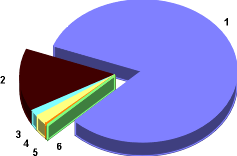The Cloning of Animals:
"Scientists have been cloning animals for many years and hundreds of cloned animals exist today, but the number of different species is limited."(Human Genome Project)
Comparison between Artificial and Natural twins, short clip (video here)
- 83% Rats, mice and other rodents. All specially bred laboratory species
- 14% Fish, amphibians, reptiles and birds (including many fertilised hen's eggs)
- 0.7% Small mammals other than rodents, mostly rabbits and ferrets
- 1.9% Sheep, cows, pigs and other large mammals
- 0.3% Dogs and cats. Specially bred for research. No strays or unwanted pets can be used
- 0.15% Monkeys, such as marmosets and macaques. Chimpanzees,
orang-utans and gorillas have not been used in this country for over 20 years
and their use is now banned." (RDS-online)

"Since the 1970s scientists have been able to clone mammals such as sheep and monkeys, using cells taken from embryos. What made the cloning of Dolly the sheep so remarkable was that she was cloned from the cell of an adult sheep – something that scientists thought couldn't be done." as stated by Nova.
"It is estimated that UK meat and fish eaters consume 2.5 billion animals every year, nearly 1,000 times the number that are used in research.
Official figures show that UK abattoirs slaughter 900 million poultry, and 30 million cattle, sheep and pigs every year. These figures do not include imported meat; the UK is probably a net importer so it is likely that we consume close to 1 billion farm animals a year. Tonnage figures from the Marine Fisheries Agency together with estimates for average weight of fish suggest that, in addition, we consume about 1,500 million sea fish and 80 million farmed salmon." With this quote from RDS-online you can see that cloning can help with the shortage of food and be able to produce more food so we wont run out and with the cloning of animals we will be able to distribute food not just for us but for all the third world country's that are low or have no food
The Cons of Animal Cloning
The process of cloning animals is far from perfected and only one to four percent of cloning attempts, if any, generally succeed.
If the low success rates can be improved, reproductive cloning can be used to develope efficient ways to reliably reproduce animals with special qualities. For example, drug producing animals or animals that have been genetically altered to serve as models for studying human disease could be mass produced.
"As researchers continue to refine their techniques and clone even more animals, some people are worried. So far, cloned animals haven't fared well", critics say. Few cloning attempts are successful. The animals that do survive tend to die young.
The FDA has moved one step closer to allowing animal clones out of the lab and into the grocery store.
Another application is the use of genetically modified pigs as a source of organs suitable for transfer to humans (xenotransplantation.)
First, though, there are plenty of kinks still to be worked out. Cloning is a delicate procedure, and lots can go wrong along the way. "It's really quite remarkable that it works at all," Westhusin says. "There are lots of ways we know it doesn't work. The more difficult question is to figure out how sometimes it does."
Although, animals rights, health and safety concerns, costs and technical barriers all need to be taken into account.
Anti-cloning bills have been introduced in more than 30 state legislatures. "Animals should not be treated as objects." (MegaEssays)